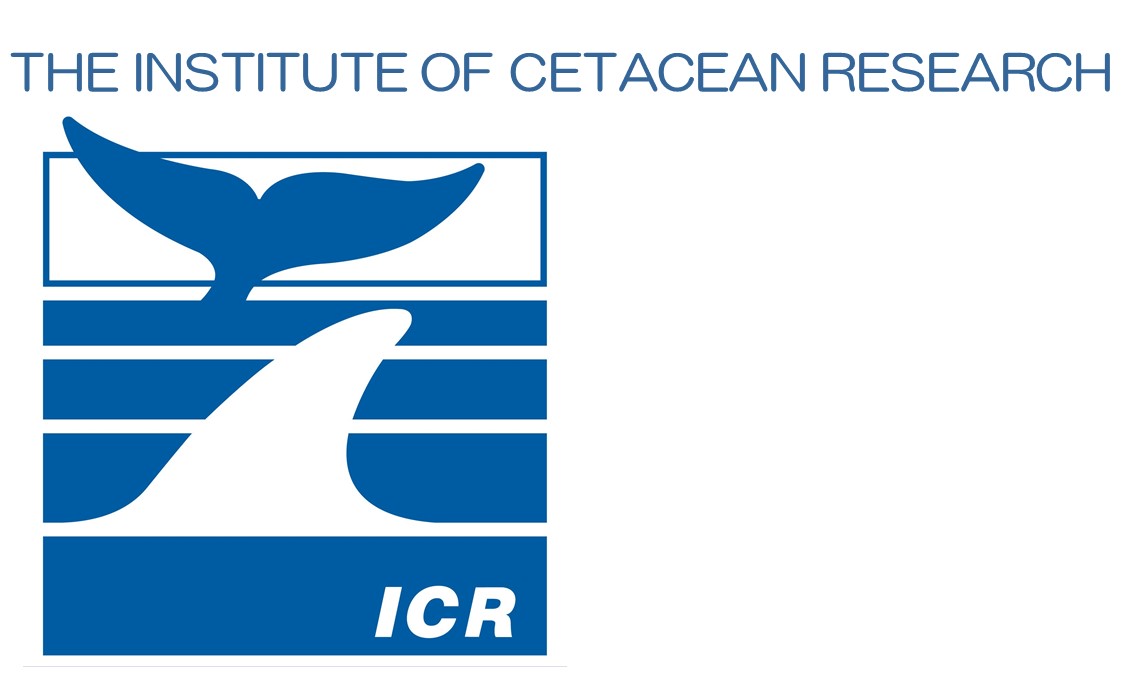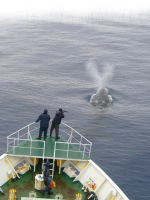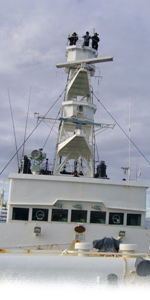Completion of Japanese Abundance and Stock-structure Surveys in the Antarctic (JASS-A) 2021/2022 Research Cruise
March 21, 2022
Designated Corporation for Scientific Whale Research
THE INSTITUTE OF CETACEAN RESEARCH
1. Background
This research program is a continuation of the Japanese government's research program (non-lethal research) aimed at the sustainable use of whale resources in the Antarctic Ocean, and this survey is the third research cruise in the Antarctic Ocean after Japan's withdrawal from the International Whaling Commission (IWC) on June 30, 2019. This year's research in the Antarctic Ocean included a sighting survey, biopsy sampling, satellite tagging, oceanographic observation and collection of other relevant information on cetaceans.
The scientific information obtained from this research will be provided to relevant international organizations such as the IWC Scientific Committee, the Ecosystem Monitoring and Management Working Group of the Commission for the Conservation of Atlantic Marine Living Resources (CCAMLR) and the Scientific Committee of the North Atlantic Marine Mammal Commission (NAMMCO) in order to contribute to the appropriate management of whale resources in the Antarctic Ocean.
The research vessel Yushin-Maru No. 2 departed from Shiogama, Miyagi Prefecture on December 3, 2021 and returned to Shiogama on March 21, 2022 after conducting research for 33 days (from January 11 to February 12, 2022) in the south of 60 degrees south latitude.
2. Survey plan and summary of results
This survey is financially supported by the Fisheries Agency, and the Institute of Cetacean Research takes the lead in planning, implementing and conducting analyses of data obtained from the survey.
This year's research area was the eastern part of Area VI, one of the IWC management areas of the Antarctic Ocean (south of 60 degree south latitude and between 120 and 135 degree west longitude). As for the sighting survey, since a bay-shaped open sea area was observed to the south, a survey was conducted from 120 to 130 degrees west longitude to collect consistent sighting data necessary for estimating whale abundance. In addition, non-lethal survey data were collected through the collection of numerous biopsy samples and the attachment of satellite tags.
The survey confirmed that multiple whale species including blue, Antarctic minke, fin, and humpback whales, were distributed in the same area. In particular, minke whales were found in high densities in the southernmost bay-like open areas. The encounter rate of Antarctic minke whales (the number of Antarctic minke whale schools found per 100 nautical miles) was 1.50 in the northern part of the research area, 1.57 in the southern part, and 18.40 in the southernmost, bay-like open area, so there was a noticeable difference by location. Although Antarctic minke whales are known to be distributed southernmost in the Antarctic Ocean, it is believed that in recent years, global warming has melted a part of the fast ice, making them move into the southernmost bay-like open areas within the fast ice where research vessels are unable to enter. The survey of the southernmost bay-like open area in this research cruise was a major achievement, as we were able to confirm a high-density distribution of Antarctic minke whales and obtain important information on the distribution of this species in the feeding grounds. The large number of fin and humpback whales distributed in the northern part of research areas and the several sightings of rare species of blue whales were considered to indicate a recovery of the species. We were also able to collect valuable information on the interaction among multiple whale species.
2.1 Main Research Objectives
The main research objectives of JASS-A are:
(1) Study of abundance and their trends of large whale species in the Antarctic Ocean.
(2) Study of the distribution, movement and stock structure of large whale species in the Antarctic Ocean.
2.2 Research Cruise and Survey Period
Research Cruise:
From December 3, 2021 to March 21, 2022 (109 days).
Number of survey days (within the research area):
From January 11 to February 12, 2022 (33 days).
2.3 Research Area
This year's survey area was the eastern part of Area VI, one of the IWC management areas in the Antarctic Ocean, south of 60 degrees south latitude and between 120 and 135 degrees west longitude (Figure 1). The sighting survey was conducted in the area between 120 and 130 degrees west longitude. In addition, mid- and low-latitude sighting surveys were conducted during the cruise to and from the research area, south of 0 degrees latitude.
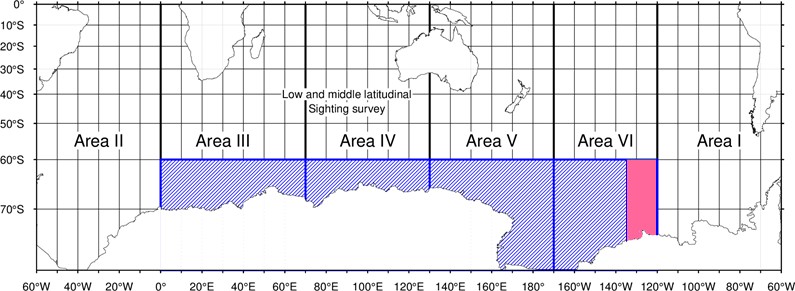
Figure 1. JASS-A Research Area. The 2021/2022 survey area is shown in pink. The blue box indicates all research areas.
2.4 Researchers
Three researchers led by Tatsuya Isoda (Cruise leader, Institute of Cetacean Research).
2.5 Research Vessel
Yushin-Maru No. 2, (747 tons, Captain Hidenori Kasai, 16 crews in total).
Nineteen members led by the Cruise Leader Isoda and the Captain Kasai were on board to engage in the research.
2.6 Implementing Body
Designated Corporation for Scientific Whale Research - The Institute of Cetacean Research.
2.7 Total Search Distance (including mid- and low-latitude sighting survey)
2,997.6 nautical miles (about 5,551.6 km).
2.8 Main whale sightings (including mid- and low-latitude sighting survey)
Blue whale: 6 schools; 7 animals
Fin whale: 58 schools; 92 animals
Antarctic minke whale: 106 schools; 169 animals
Humpback whale: 35 schools; 53 animals
Sei whale: 1 school; 1 animal
Bryde's whale: 1 school; 1 animal
Sperm whale: 14 schools; 15 animals
Killer whale: 5 schools; 71 animals
Southern bottlenose whale: 1 school; 1 animal
Arnoux's beaked whale: 2 schools; 11 animals
2.9 Results of various Experiments and Observations
(1) Distance angle estimation experiment
A preliminary distance-angle estimation experiment was conducted to determine the accuracy of the estimation of the angle and distance of detection by each visual observer.
(2) Individual identification photo shooting (number of individuals)
Blue whale (7 animals), humpback whale (9 animals), killer whale (10 animals).
(3) Biopsy sample collection (number of individuals)
Blue whale (2 animals), fin whale (12 animals), Antarctic minke whale (15 animals), humpback whale (11 animals), Bryde's whale (1 animal), killer whale (2 animals).
(4) Satellite tag attachment experiment
Satellite tags were attached to 9 fin whales and 14 Antarctic minke whales to record their migration and diving behavior.
As a result, a tendency to move offshore was detected on fin whales (Figure 2) On the Antarctic minke whales, there was a strong tendency to move westward, and some individuals were observed moving further south into the Ross Sea (Figure 3).
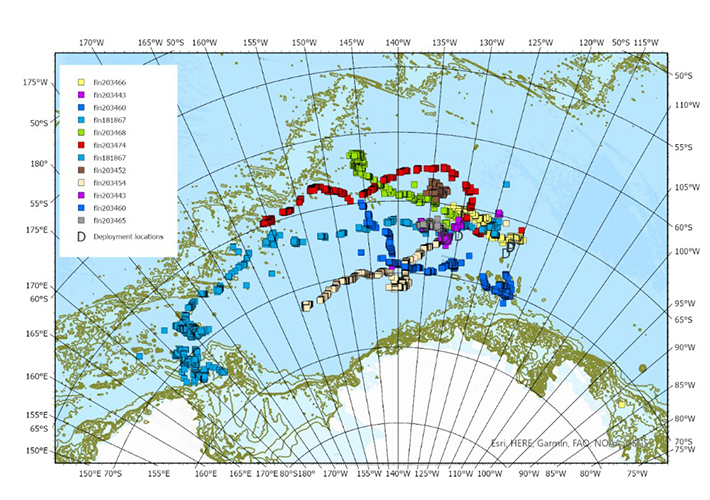
Figure 2. Movement paths of fin whales with satellite tags (information through March 10, 2022). Green lines indicate depths from 200m to 3000m.
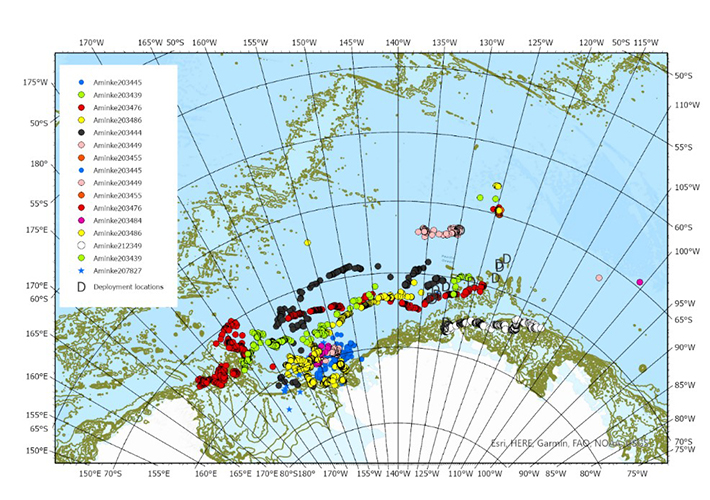
Figure 3. Movement paths of Antarctic minke whales with satellite tags (information through March 10, 2022). Green lines indicate depths from 200m to 3000m.
(5) Oceanographic observation by XCTD (Expendable Conductivity-Temperature-Depth probe)
Water temperature and salinity were measured at 116 stations from 0 to 1,850m depth for the purpose of comparing oceanographic structure and cetacean distribution in the research area.
(6) Preliminary experiment using drones
Preliminary photogrammetry experiments were conducted using drones to measure the body length and body condition of cetaceans and to observe their swimming behavior.
We succeeded in photographing blue, Antarctic minke and humpback whales.
(7) Observation of marine debris
This year, a single marine drifting object (a rubber buoy) was observed in the research Area.
3. 2021/2022 JASS-A Research Cruise photographs
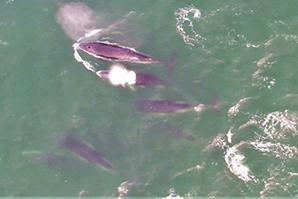 |
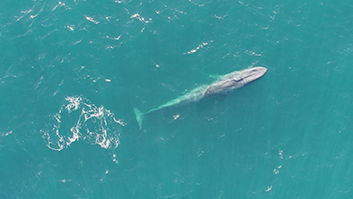 |
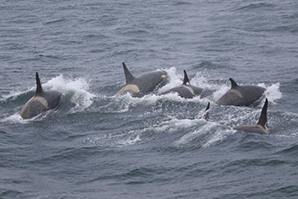 |
|
| Antarctic minke whales (drone image) | Blue whale (drone image) | Killer whale pod | |
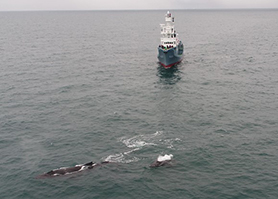 |
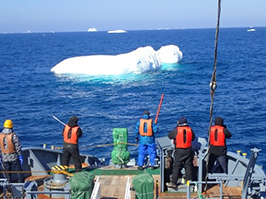 |
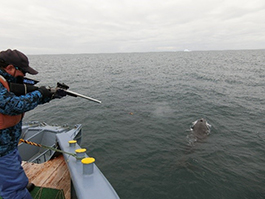 |
|
| Observation of humpback whales (drone image) | Biopsy collection and satellite tag attachment experiment | Scene from a biopsy experiment (humpback whale) | |
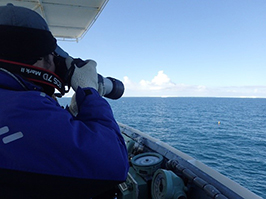 |
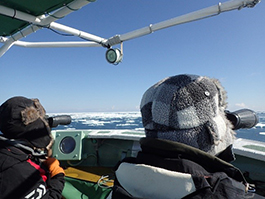 |
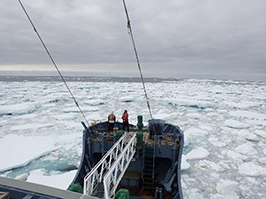 |
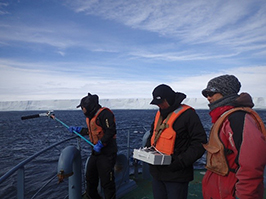 |
| Marine debris observation | Searching for whales among the sea ice | The Yushin-Maru No. 2 navigates through sea ice | Oceanographic observation by XCTD near the ice shelf |
Video footage of the survey is available on the Institute's YouTube channel.https://www.youtube.com/watch?v=mjj-0OdolDE
Completion of Japanese Abundance and Stock-structure Surveys in the Antarctic (JASS-A) 2021/2022 Research Cruise (PDF file)
